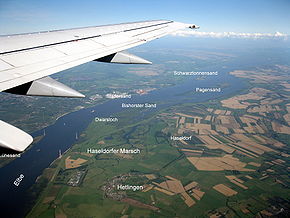Bishorst
Bishorst is a village in what is now the Pinneberg district in Schleswig-Holstein that sank into the Elbe during a severe storm surge in the 18th century .
history
Presumably a church in Bishorst has existed since the 9th century . Later the village developed into a parish and the spiritual center of the Haseldorfer Marsch . Around 1125 the mission apostle received Vicelin Bishorst as a gift. However, the name was first mentioned in 1142 in the deed of donation from Archbishop Adalbero of Bremen to Vicelin. When the Wends hit the Holstenland in the 12th century , Vicelin and his colleagues withdrew to the protected mission village. Later the church was incorporated into the Bordesholm monastery .
In the 12th century, churches were built in the villages of Haseldorf , Haselau , Seester and Seestermühe . Around 1500 the parish of Bishorst had lost its importance and only around 150 inhabitants; so the church was sold to a private person. Later it was destroyed in the flood of All Saints in 1532 . An old record reports: "The tide is said to have gone a ton over the dykes and drowned many people and cattle, and washed away the churches of Asfleth and Bishorst."
Although the flood destroyed almost everything, people initially still lived in the village of Bishorst. But further storm surges repeatedly destroyed parts of the village. On April 16, 1745, a devastating storm surge occurred. The Haselau estate inspector at the time reported: “ In Bishorst the dikes are almost entirely ruined. A brackish has come in which is about 30-40 rods (140 to 180 m) in width and length and six fathoms (10 m) deep, so that we only have the wild sea around us. By brackish flows ebb and flood resistant. If the flood had come at night, many people and cattle would have perished. My mind is very sick and the need is great. Bishorst is completely lost. If the houses are not to be washed away, they have to be demolished. "
After the flood, only a few residents lived in their houses for a few years. The last houses were destroyed in a new flood in 1751, which wiped out the village of Bishorst. The last families moved to Altendeich , and the remains of Bishorster cottages were used as building materials for the new houses .
Today the former village of Bishorst lies sunk in the Elbe. Remains are a mound and the ash avenue at the settlement site. Occasionally, remains of the place are exposed by the strong current of the Elbe.
The "Bishorster Sand", a low vegetation and protected Elbe island, still reminds of the name and the location of the place.
Web links
- Schleswig-Holstein Nature Conservation Foundation: Haseldorfer March
- The sunken parish of Bishorst
- Bishorster Sand at NABU
Coordinates: 53 ° 39 ′ 26 " N , 9 ° 32 ′ 58.5" E


